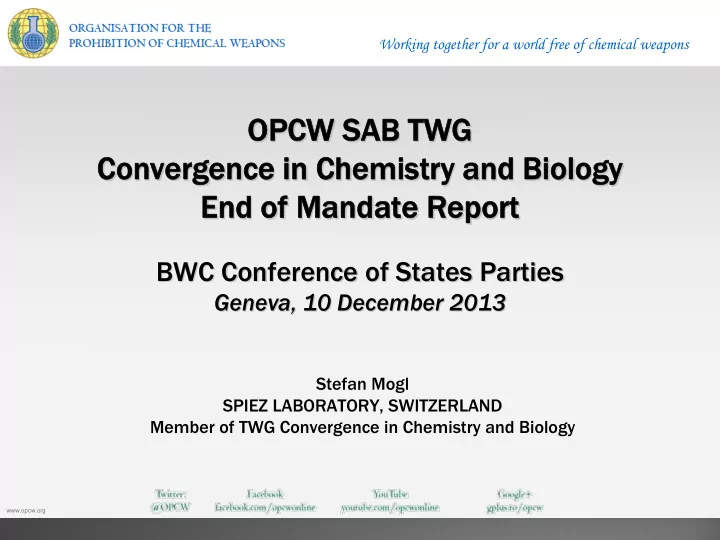

Working together for a world free of chemical weapons OPCW SAB TWG OPCW SAB TWG OPCW SAB TWG OPCW SAB TWG Convergence in Chemistry and Biology Convergence in Chemistry and Biology Convergence in Chemistry and Biology Convergence in Chemistry and Biology End of Mandate Report End of Mandate Report End of Mandate Report End of Mandate Report BWC Conference of States Parties BWC Conference of States Parties Geneva, 10 December 2013 Geneva, 10 December 2013 Stefan Mogl SPIEZ LABORATORY, SWITZERLAND Member of TWG Convergence in Chemistry and Biology www.opcw.org
Working together for a world free of chemical weapons Outline Outline • Background to SAB TWG Convergence • Findings • Recommendations www.opcw.org
Working together for a world free of chemical weapons Background to SAB TWG Convergence Background to SAB TWG Convergence (CWC, Art. VIII, para para 21 h), 45) 21 h), 45) (CWC, Art. VIII, • OPCW Scientific Advisory Board (SAB) − Advises OPCW Director-General − 25 Experts appointed by him, serving in individual capacity for a max. of six years • SAB Temporary Working Groups − Established by OPCW DG, on recommendation of SAB − Chaired by SAB, reports to SAB, expert membership − Mandate of limited duration (2-3 years) www.opcw.org
Working together for a world free of chemical weapons Findings (1) Findings (1) Biology is making chemistry; chemistry is making biology: Biology is making chemistry; chemistry is making biology: The growing overlap between chemical and biological production technologies, and the science that underpins them, is enabling biologically mediated production of chemicals and the chemical synthesis of biological molecules and systems. [J.B. Tucker, 2010] www.opcw.org
Working together for a world free of chemical weapons Findings (2) Findings (2) • 10% of Chemical Production using biologically meditated processes by 2020 − Drivers: Commercial, environmental, competition for feedstock • Rapidly expanding capability to redesign or manipulate organisms for specific purpose and to design and engineer improved enzymes − Metabolic engineering − Enzyme engineering − Synthetic biology − Recombinant DNA technology www.opcw.org
Working together for a world free of chemical weapons Findings (3) Findings (3) • This biotechnology could be applied to the production of new toxic chemicals, bioregulators and toxins • Potential application for production of CWC Schedule 1 or 2 chemicals assessed currently as limited • Note: Development and scaling up of a new biological process for commercial production takes considerable investment of capital, resources and time www.opcw.org
Working together for a world free of chemical weapons Findings (4) Findings (4) • Substantial advances in the chemical synthesis of molecules of biological origin − Automated DNA synthesis of whole genomes − Reconstruction of simple viruses − Semi automated synthesis of peptides (pharmaceuticals, bioregulators) − Chemical synthesis of increasingly more complex biological molecules, including toxins • Limited scale of such synthesis currently poses no threat to CWC www.opcw.org
Working together for a world free of chemical weapons Findings (5) Findings (5) • Enabling technologies are critical factors affecting pace of change and convergence in life sciences − DNA sequencing and synthesis − Informatics, computing capacity − Availability of technical data on the Internet − Automated robotics in R&D • Multidisciplinary research teams are becoming the norm (chemistry, biology, physics, computing, engineering, materials science, nanotechnology) www.opcw.org
Working together for a world free of chemical weapons Findings (6) Findings (6) • Increasing use of biologically mediated production processes has implications for CWC industry verification regime • The TWG reviewed meaning of the term 'produced by 'produced by synthesis' (CWC, Verification Annex, Part IX) synthesis' − Declarations for ‘Other Chemical Production Facilities’ • Any process designed for the formation of a chemical • Any process designed for the formation of a chemical substance should be covered by the term 'produced by substance synthesis‘ − Exemptions may be scientifically justified www.opcw.org
Working together for a world free of chemical weapons Findings (7) Findings (7) • New production processes, combined with developments in drug discovery and delivery could be exploited for prohibited purposes − Such developments are covered by ‘General purpose criterion‘ (CWC, Art. II, definition of toxic chemicals) − Important to monitor developments in S+T • Increasing overlap between CWC and BWC due to Convergence − Requires interaction between CWC and BWC technical experts www.opcw.org
Working together for a world free of chemical weapons Findings (8) Findings (8) • Nanotechnology is converging in a significant way with chemistry and biology − Drug delivery to the body − Biosensors • Convergence is providing major benefits − Health care − Alternative energy sources − Environmental control − Defensive countermeasures against CWA and BWA www.opcw.org
Working together for a world free of chemical weapons Recommendations by TWG (1) Recommendations by TWG (1) • Monitor advances in production technologies • Monitor advances in production technologies − Assess relevance to verification under the CWC • Monitor advances in systems and synthetic biology • Monitor advances in systems and synthetic biology − Assess capability and capacity to synthesise more complex chemicals (toxic chemicals, toxins and bioregulators) • Monitor advances in nanotechnology • Monitor advances in nanotechnology − particularly as they apply to improved defensive countermeasures www.opcw.org
Working together for a world free of chemical weapons Recommendations by TWG (2) Recommendations by TWG (2) • Assistance to delegations to help understand possible • Assistance to delegations to help understand possible implications implications − Develop outreach material • Establishing structured approach for contact between • Establishing structured approach for contact between CWC and BWC CWC and BWC − Bring together technical expertise in areas of common interest • Re- -activating TWG on Convergence periodically activating TWG on Convergence periodically • Re − In time for SAB report on S&T for CWC Review Conference (every 5 years) www.opcw.org
Working together for a world free of chemical weapons OPCW SAB TWG OPCW SAB TWG OPCW SAB TWG OPCW SAB TWG Convergence in Chemistry and Biology Convergence in Chemistry and Biology Convergence in Chemistry and Biology Convergence in Chemistry and Biology Reports: Reports: Reports: Reports: http://www.opcw.org/about-opcw/subsidiary- http://www.opcw.org/about-opcw/subsidiary- bodies/scientific-advisory-board/documents/reports/ bodies/scientific-advisory-board/documents/reports/ www.opcw.org
Recommend
More recommend